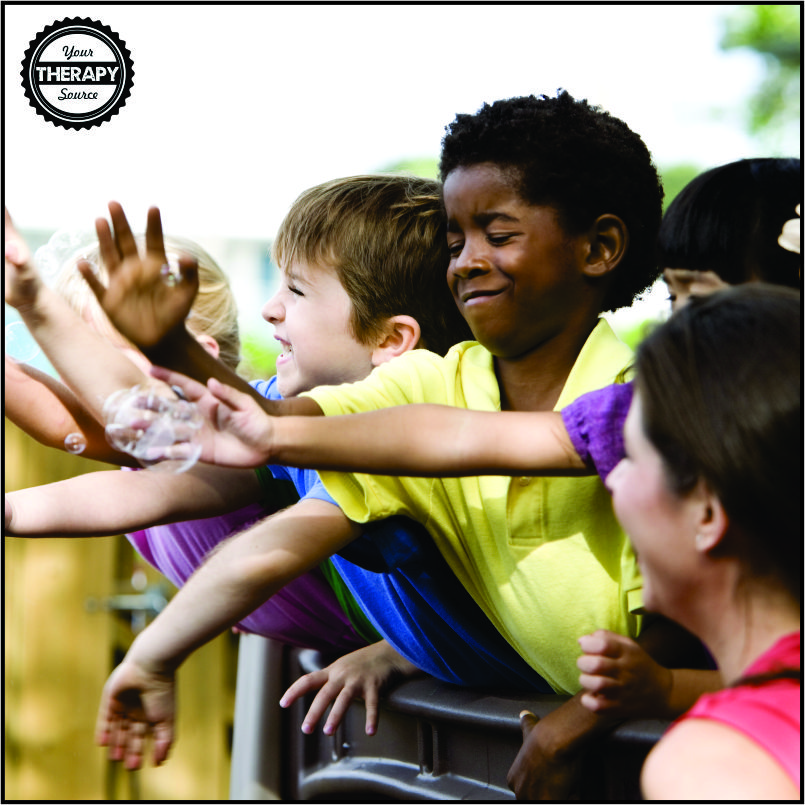Helping Children with Autism on the Playground

Most children in the United States do not get enough physical activity per day including young children with autism. When children do not get the recommended moderate to vigorous physical activity (MVPA) per day they are at greater risk for obesity, high cholesterol, high blood pressure, low bone density, asthma, and depression. Research indicates that children who are physically active at school are more likely to engage in MVPA outside of school. Many young children with autism qualify for preschool services, therefore the school can encourage increased amounts of MVPA per day. Currently, the guidelines suggest that preschool students should have access to both 60 min of structured physical activity and 60 min of unstructured physical activity each day . How can teachers and related service providers help children with autism on the playground?
Children with Autism and Physical Activity
With regards to children with autism specifically, research indicates that this group of children engages in less MVPA per day than their typical peers. When children with autism participate in MVPA, it has been shown to decrease stereotypy and problem behaviors and increase academic engagement.
Previous research suggests that preschool teachers can help all students increase MVPA per day by:
- including teacher-led physical activities.
- providing a large variety of portable materials.
- encouraging participation in active play and physical activity.
Children with Autism and the Playground
What does the research say about helping children with autism on the playground? Research was published in Focus on Autism and Other Developmental Disabilities to determine if low- and high-effort teacher interventions result in increases in the:
- percent of time spent appropriately engaged with peers or materials.
- number of social interactions
- percent of time spent in proximal play
- percentage of time spent in MVPA.
This was a alternating treatment design with two young children (55 and 56 months old) with autism.
During the low effort intervention the teacher provided access to randomly selected portable materials (ie bubbles) and interacted with the student every two minutes with reminders regarding the portable materials or positive/neutral feedback.
For the high effort intervention, the teacher offered a choice between two age appropriate activities using the portable materials. Again, the teacher interacted every two minutes if needed. The high effort intervention attempted to encourage social behavior as well by allowing other children to participate but only the student participant in the study had access to the portable materials. The other children had to ask the student to join the activity.
The final intervention was the enhanced intervention which was the same as the high effort intervention but also included prompting the students to participate in physical activity every 2 minutes (ie “let’s run and get the bubbles”).
Results of the Study
The results of the study on children with autism and the playground indicated the following:
- engagement and social behaviors increased during a structured choice (SC) intervention condition.
- MVPA was variable within and across conditions, but appropriate physical activity (e.g., physical activity that was associated with engagement) was highest during the SC condition.
- the enhanced intervention showed minimally higher physical activity with sustained social and engagement behaviors.
This research suggests that teachers can offer activity choices using portable materials to increase MVPA with appropriate engagement in young children with autism.
Reference: Jennifer R. Ledford, Justin D. Lane, Collin Shepley, and Sarah M. Kroll. Using Teacher-Implemented Playground Interventions to Increase Engagement, Social Behaviors, and Physical Activity for Young Children With Autism. Focus on Autism and Other Developmental Disabilities September 2016 31: 163-173, first published on August 21, 2014 doi:10.1177/1088357614547892
Read More On Increasing Engagement on the Playground
Resources to Help Children with Physical Activity
Teaching Catching, Throwing and Kicking Skills: Help children learn how to catch, throw and kick with this digital packet full of information of age progression of skills, visual picture cards, tips, letter to parents and more!
Research tells us that short aerobic exercise sessions can help children with: cognitive flexibility, self-regulation, behavior, and academic achievement! This Cardio Aerobic Exercises for Small Spaces digital download packet includes 15 aerobic exercise sheets including QR codes with links to animated video demonstration of each exercise.




